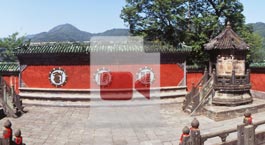2012-11-28
Taoism is a religion native to China. Laozi, (also spelled Lao-Tse, Lao Tsu, Lao Tzu, etc.) a famous thinker living in 6th Century BC, established this philosophy and came to be regarded as the father of Taoism. It formed mainly during Eastern Han Dynasty (AD 25-220). Many Taoist ideas and thoughts are greatly reflected in Taoist architecture.
2012-11-27
Taoism is a religion native to China. Laozi, (also spelled Lao-Tse, Lao Tsu, Lao Tzu, etc.) a famous thinker living in 6th Century BC, established this philosophy and came to be regarded as the father of Taoism. It formed mainly during Eastern Han Dynasty (AD 25-220). Many Taoist ideas and thoughts are greatly reflected in Taoist architecture.
2012-11-26
Taoism is a religion native to China. Laozi, (also spelled Lao-Tse, Lao Tsu, Lao Tzu, etc.) a famous thinker living in 6th Century BC, established this philosophy and came to be regarded as the father of Taoism. It formed mainly during Eastern Han Dynasty (AD 25-220). Many Taoist ideas and thoughts are greatly reflected in Taoist architecture.
2012-11-23
Taoism is a religion native to China. Laozi, (also spelled Lao-Tse, Lao Tsu, Lao Tzu, etc.) a famous thinker living in 6th Century BC, established this philosophy and came to be regarded as the father of Taoism. It formed mainly during Eastern Han Dynasty (AD 25-220). Many Taoist ideas and thoughts are greatly reflected in Taoist architecture.
2012-11-22
Taoism is a religion native to China. Laozi, (also spelled Lao-Tse, Lao Tsu, Lao Tzu, etc.) a famous thinker living in 6th Century BC, established this philosophy and came to be regarded as the father of Taoism. It formed mainly during Eastern Han Dynasty (AD 25-220). Many Taoist ideas and thoughts are greatly reflected in Taoist architecture.
2012-11-21
Taoism is a religion native to China. Laozi, (also spelled Lao-Tse, Lao Tsu, Lao Tzu, etc.) a famous thinker living in 6th Century BC, established this philosophy and came to be regarded as the father of Taoism. It formed mainly during Eastern Han Dynasty (AD 25-220). Many Taoist ideas and thoughts are greatly reflected in Taoist architecture.
2012-11-20
Taoism is a religion native to China. Laozi, (also spelled Lao-Tse, Lao Tsu, Lao Tzu, etc.) a famous thinker living in 6th Century BC, established this philosophy and came to be regarded as the father of Taoism. It formed mainly during Eastern Han Dynasty (AD 25-220). Many Taoist ideas and thoughts are greatly reflected in Taoist architecture.
2012-11-19
Taoism is a religion native to China. Laozi, (also spelled Lao-Tse, Lao Tsu, Lao Tzu, etc.) a famous thinker living in 6th Century BC, established this philosophy and came to be regarded as the father of Taoism. It formed mainly during Eastern Han Dynasty (AD 25-220). Many Taoist ideas and thoughts are greatly reflected in Taoist architecture.
2013-05-24
Wudang Mountain is famous for its perfect combination of natural and cultural scenery. It is also renowned for its magnificent ancient buildings, profound traditional Taoist culture and Wudang kungfu.
2013-04-10
The ancient Yuzhen Palace is one of the most sacred site of Taoism. It was built by Emperor Chengzu of the Ming Dynasty some 600 years ago in a tribute to the mythical Taoist priest Zhang Sanfeng.
2012-08-15
Play Video Wudang Mountain in Hubei province is renowned for its well preserved taoist palaces and temples dating back to the Yuan, Ming and Qing dynasties. These palaces and temples together were included on the World Heritage List by UNESCO in 1994.
2011-07-27
Since time of immemorial, Wudang Mountain has been a mysterious place which inspired the faithful and invited the followers of Taoism to find shelter and spiritual healing in the secluded subtropical mountain of central China.



